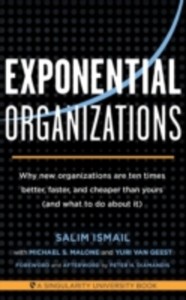 Salim Ismail wrote, together with Yuri van Geest and Michael S. Malone, Exponential organizations – Why new organizations are ten times better, faster, and cheaper than yours (and what to do about it). These exponential organizations are able to show an exponential growth curve due to the integral application of communities, big data, smart algorithms and new, innovative technologies. The authors used research into hundreds of startups and interviews with CEO’s of the fast-growing companies (Airbnb, Netflix, Tesla, Waze, et cetera).
Salim Ismail wrote, together with Yuri van Geest and Michael S. Malone, Exponential organizations – Why new organizations are ten times better, faster, and cheaper than yours (and what to do about it). These exponential organizations are able to show an exponential growth curve due to the integral application of communities, big data, smart algorithms and new, innovative technologies. The authors used research into hundreds of startups and interviews with CEO’s of the fast-growing companies (Airbnb, Netflix, Tesla, Waze, et cetera).
The book consists of two parts and an introduction. The first part explores the characteristics and implications of exponential organizations. The second part deals with the practical implementation and future vision of these organizations. You get tools to implement the exponential organization model in your own organization too.
Moore’s law will be known to many. Every eighteen months the price / performance of computing power doubles. And this has already been applicable for the last sixty years. However, this exponential doubling is much more common, but predicting a technology when it doubles is always dangerous. The Human Genome Project was set up in 1990 with the aim of completely unraveling a single human genome. According to various predictions, the project would take 15 years and cost $ 6 million. Every expert called the project a failure in 1997, pointing out that if only 1 percent were unraveled in 1997, it would take seven hundred years for the entire genome to be mapped. According to Ray Kurzweil, the 1% meant they were halfway. Double 1% seven times was 100%. The project was completed in 2001!
Almost by definition, exponential organizations (ExOs) all think big and this is reflected in the higher ambitious goal of the organization. The massive transformative purpose (MTP) statement is formulated for this purpose.
 To download: QRC (ExO EN, 191021) v1.0
To download: QRC (ExO EN, 191021) v1.0
ExO’s are described by five external (SCALE) and five internal (IDEAS) elements. To classify as an ExO you need to have a Massive Transformation Purpose (MTP) and at least 3-4 of the ExO-elements. In the appendix you can find a questionnaire to calculate your own exponential score. SCALE- and IDEAS-elements are self-reinforcing and integrating.
The external elements (SCALE) to improve your performance are: Staff on demand, Community & Crowd, Algorithms, Leveraged assets, Engagement. ExOs scale up beyond the boundaries of their own organization by using or gaining access to people, assets and platforms to maximize flexibility, speed, agility and learning processes.
In addition, the controlling framework of the five internal elements (IDEAS) is described, which manages the abundant output of the external SCALE elements: Interfaces, Dashboards, Experimentation, Autonomy, Social.
In addition to the aforementioned characteristics, the authors have determined nine key dynamics at play for the ExO ecosystem:
- Information accelerates everything
- Drive to demonetization
- Disruption is the new norm
- Beware the “expert”
- Death to the five-year plan
- Smaller beats bigger
- Rent, don’t own
- Trust beats control, open beats closed
- Everything is measurable and anything is knowable.
In the second part the authors explain how to start an ExO by using examples and they offer a step-by-step plan:
- Select a massive transformative purpose (MTP)
- Join or create relevant MTP communities
- Compose a team
- Breakthrough idea
- Build a Business Model Canvas
- Find a business model
- Build the MVP
- Validate marketing and sales
- Implement SCALE and IDEAS
- Establish the culture
- Ask key questions periodically
- Building and maintaining a platform.
In addition to setting up, attention is also paid to how you can grow an organization in the mid-market company segment, exponentially. Through examples from TED, GitHub, Coyote Logistics, Studio Roosegaarde, GoPro and how they score on the ExO elements, you get a good overview of what is possible. Finally, a number of strategies are discussed with which large organizations can align themselves with ExO concepts while retaining their core activities transform leadership, partner with, invest in or acquire ExOs, disrupt and implement ExO lite internally.
By using examples from Bridgewater, Coca-Cola, Haier, Xiaomi, The Guardian, GE, Amazon, Zappos, Tangerine, and Google Ventures, among others, the authors explain how these strategies have been put into practice by showing their exponential score. The book concludes with a chapter on exponential executives including the CEO, CMO, CFO, CTO / CIO, Chief Data Officer (CDO), Chief Innovation Officer (CIO), COO, Chief Legal Officer (CLO), and the CHRO.
Conclusion. Is this era of agile transitions, a must read for senior management to understand that scaling of agile teams is not enough to survive in this twenty first century? The book offers a practical framework to experiment with one or more of the ExO elements.
To order: Exponential organizations
















Pingback: Overview of my year 2019 book reviews | Henny Portman's Blog
Pingback: Quick Reference Cards in 2019 | Henny Portman's Blog
Pingback: How Exponential Organizations And Compassionate Leadership Could Define The Next Decade | ExO Institute